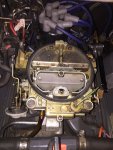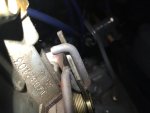The quadrajet carb on my 4.3 OMC was replaced ~4 yrs ago due to an air leak after a rebuild which wouldn't allow us to adjust the low idle mixture jets. The mechanic intentionally left the linkage off of the throttle side of the carb so the 4 barrels wouldn't kick in and said that would give me better gas mileage. I reluctantly tried it once on the water and immediately requested he put the linkage back on since I couldn't plane out very quickly and I lost 10 mph of top end speed (32mph with 2 barrels vs 42 mph with 4 barrels.
Ever since the carb replacement, I have a studder/bog issue when I go over 32 mph (4 barrels beginning to engage I believe). I could put it to WOT and get out of the hole fine, but running between 32-37 mph I get the studder. At WOT, the boat runs 4600 rpm smoothly.
I recently replaced points, condenser, rotor, small fuel filter at carb, and fuel/water separator due to severely poor running engine and everything is back to normal with the engine....and the studder from 32-37mph is still there. Points set to .017 gap to achieve 38 degrees dwell. Timing set to 6 degress BTDC @ 1000rpm.
The engine runs like a champ other than that small throttle range so I feel I am getting sufficient fuel delivery and have 6 psi coming from fuel pump. The only suspect thing I have found so far was the linkage rod on the starboard side of the carb that connects from a vacuum part to the secondary butterflies was a bit "sticky" when I manually opened the secondaries. I put a very small amount of grease in the groove that the rod slides through and that smoothed out the secondary operation.
I have not had the boat on the water since, but am looking for other possible causes until I can see if the sticky linkage was the issue.
Here is a pic of where the rod was sticking before I applied the grease.

Any suggestions or help is appreciated.
Ever since the carb replacement, I have a studder/bog issue when I go over 32 mph (4 barrels beginning to engage I believe). I could put it to WOT and get out of the hole fine, but running between 32-37 mph I get the studder. At WOT, the boat runs 4600 rpm smoothly.
I recently replaced points, condenser, rotor, small fuel filter at carb, and fuel/water separator due to severely poor running engine and everything is back to normal with the engine....and the studder from 32-37mph is still there. Points set to .017 gap to achieve 38 degrees dwell. Timing set to 6 degress BTDC @ 1000rpm.
The engine runs like a champ other than that small throttle range so I feel I am getting sufficient fuel delivery and have 6 psi coming from fuel pump. The only suspect thing I have found so far was the linkage rod on the starboard side of the carb that connects from a vacuum part to the secondary butterflies was a bit "sticky" when I manually opened the secondaries. I put a very small amount of grease in the groove that the rod slides through and that smoothed out the secondary operation.
I have not had the boat on the water since, but am looking for other possible causes until I can see if the sticky linkage was the issue.
Here is a pic of where the rod was sticking before I applied the grease.

Any suggestions or help is appreciated.























